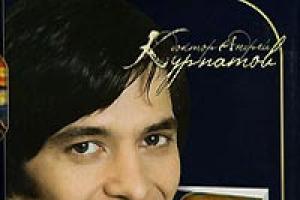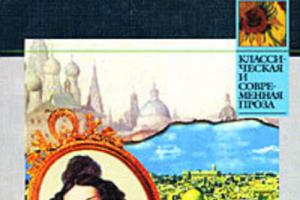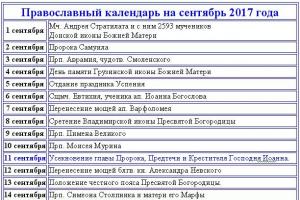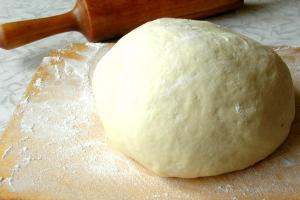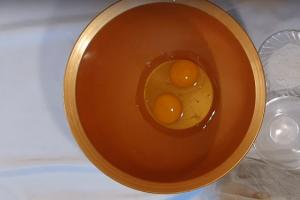Moscow region Education Management Administration
Istrinsky municipal district MDOU TsRR - d/s No. 46 “Swallow”
OO Artistic and Aesthetic Development
Summary of educational activities for drawing with children of the preparatory group for school on the topic:
“Health is good - thanks to exercise”
Educator:
Mishina S.N.
Glebovsky village
2015
Target: Contribute to the formation of children's ideas about the benefits motor activity for the body.
Program content:Strengthen children's ability to draw a human figure in motion. To give children a general idea of health as a value that must be constantly taken care of. Cultivate a caring attitude towards your health, form healthy lifestyle habits.
Progress of the lesson.
Guys, why do we do physical education? What do you enjoy doing most in physical education class? What is physical education and what is sport? How are physical educators different from athletes? How many of you want to become an athlete? What should you do for this? Do you think it is easy to become an athlete?
Is it necessary to engage in physical education for someone who plans to become not an athlete, but a salesman, a cook, or a driver? Of course yes. After all, physical education improves health; a person gets sick less, becomes cheerful, energetic, slim and fit.
Tell us how you and your parents engage in physical education and do morning exercises.
I suggest you draw how you do physical education classes, how you do morning exercises at home or in kindergarten. The subjects of the drawings are discussed.
Physical education minute(movements are performed according to the text)
We checked our posture and brought our shoulder blades together,
We walk on our toes and then on our heels.
Let's go softly, like little foxes, and like a clumsy bear,
And like a little bunny coward, and like a gray little wolf.
The hedgehog curled up into a ball because he was cold.
The ray touched the hedgehog, the hedgehog stretched sweetly.
Children come out and talk about their work. An exhibition is being made of children's works.
Let's do itmorning exercises:
So that we grow strong, dexterous and brave (exercise “Strongman”)
Every morning we do exercises (walking in place)
We raise our hands to the sun, then lower them down, (according to the text)
We squat and stand up and don’t get tired at all. (according to the text)
Well done guys, it’s immediately obvious how strong and healthy you have become
On the topic: methodological developments, presentations and notes
Summary of direct educational activities in the preparatory group "Health is fine - thanks to exercise"
The teacher introduces children to the human body, how to strengthen its muscles....
Goal: Fix the score within 7. Program content: 1. Fix the score within 7.2. To consolidate knowledge about the days of the week, their sequence and interre...
Summary of joint activities with children of primary preschool age on the walk “Is your health okay? Thanks to the charger!”
Organized educational activities for physical culture in the air "Is your health okay? Thanks for exercise!"...
Goal: To form in children the concept of human “health”. Develop a desire to take care of your health and maintain it through various activities.
Materials: a chest, a crossword puzzle, riddles, a list of questions for a word game in pictures, diagrams for the m/n game “Men”, an apple puzzle with proverbs, a bag of groceries, cards with vitamins and poems, a mirror cut from a sheet of “mirrors” , markers, pencils, music.
Move: SURPRISE
Educator: Today we have a chest in our group!
It says: “A wonderful chest of wise things for older children!”
Let's see! There are so many interesting items here! What do we need them for?
1. CROSSWORD.
Do you know what a crossword puzzle is? These are tasks - thinking.
You need to select words according to given conditions. And the conditions here are a mystery! We listen carefully and guess the words in the boxes.
1.I saw my portrait.
He walked away - there was no portrait.
And it shines and shines,
It doesn’t flatter anyone, -
And he will tell anyone the truth -
He will show everything as it is. (Mirror)
2. The rain is warm and thick,
This rain is not easy:
He is without clouds, without clouds
Ready to go all day (shower).
3. Slips away like something alive
But I won't let him out.
Foams with white foam,
Don't be lazy about washing your hands!
(Soap)
4. I walk, I wander not through the forests,
And by the mustache, by the hair,
And my teeth are longer,
Than wolves and mice.
(Comb)
5. Elastic band – Shark
I went for a walk along the back.
And while she was walking,
The back has become pink.
(Washcloth)
6. I am neither a sea nor a river,
I am not a lake, not a pond,
But like morning or evening -
People are all running towards me.
(Bath)
7. Silver trumpet,
From the pipe - water,
Water runs and pours
Into the whiteness of the well,
There are two brothers on the pipe,
They sit and have fun.
One in a red caftan,
The second one is in blue,
Both friends are brothers
They manage the water.
(Wash basin)
8.Bone back,
Stiff bristles
Goes well with mint paste,
Serves us diligently.
(Toothbrush)
Educator: Let's summarize, read the word in the red stripe, vertically! This word is “health”. And the crossword puzzle told us what the objects in the chest want to tell us about (about health), what to teach (to be healthy)!
2. Educator: What kind of strange book is this, there are pictures, but not all the text!
WORD GAME “I’ll start, you continue!” »
Goal: Develop the ability to start by coming up with the end of a sentence. Clarify and expand ideas about the concept of “healthy person”.
1. A healthy person is...
2. My health...
3. Sometimes I get sick because...
4. When I am sick, they help me...
5. When a person has something in pain, he...
6.When I think about my health, I want...
Educator: Do exercises!
Wish from the chest:
Fun moves
Useful movements
Who deals with them?
Worth respect
Who deals with them?
Good health
And who doesn't do it -
I'm dealing with illnesses.
3. Educator: What is in the magic chest for charging? Look, amazing people.
M/P GAME “Men” (schemes)
Goal: To develop the ability to understand schematic illustration a person, his movements, and accurately perform a given exercise. Give the opportunity to relax the muscles of the body, get + emotions.
Move: children show movements based on the images on the cards.
On the game box:
Every day in the morning
Let's do exercises
We really like it
Do it in order.
Educator: Let's go together!
Wish from the chest:
So that you don't get sick
And don't catch a cold
You're always charging
Must study.
4. Educator: There is a magic apple for health in the magic chest. Whoever collects his parts, understands all his wisdom, will gain health.
Educational GAME: “APPLE - a puzzle for health!”
Goal: To provide knowledge about health through folk wisdom in proverbs.
Progress: You need to assemble an apple from the pieces, explaining the proverbs.
- “Health is more valuable than wealth.” No doctors will return wasted health, no matter how much you pay.
- “You can’t buy health.” Health is given to us by nature, if a person loses it, then it will be very difficult to get it back, you will have to undergo a lot of treatment.
- “A person’s illness does not make a person beautiful.” A sick person always looks bad, becomes irritable and moody.
- “If you are healthy, you will achieve everything.” A healthy person will achieve everything and cope with all matters.
- “Everything is great for a healthy person” A healthy person is happy with everything, sees only good things around him.
Wish from the chest: “Here is a ripe apple for health, useful advice.” Follow the advice and stay healthy!”
5. Educator: What else is healthy for a person to eat? Guess, name and tell. (We display cards with vitamins for products)
GAME “VITAMIN BAG”
Purpose: To provide knowledge about vitamins, their benefits and dangers for the human body. Develop cognitive activity, tactile perception.
Procedure: Fruits and vegetables are placed in the bag. The child identifies the object by touch, names it, takes it out and, together with the teacher, talks about the vitamins in this fruit or vegetable.
On the bag:
To always be healthy
There's a lot to know
And how to eat right
Get vitamins!
Bananas, cereal grains, liver
They advise you to eat everything.
And in wholemeal bread
There is a valuable vitamin...(B6).
All types of oils are so beneficial,
And I advise you:
Eat more often
Products with vitamin…(E)
Parsley and sorrel are useful -
You know how twice is two.
In rowan, onion, sea buckthorn
There are vitamins of the group... (A).
Fish, eggs, pork meat
They contain a lot of...(zinc).
In black currant, rose hips, lemon-
Full of...(C) vitamin,
He's useful to everyone, guys.
From acute respiratory infections and influenza!
If you want to be healthy
And don't lie in bed -
Eat beef and cottage cheese:
They contain...(B12).
Wish for the chest:
I wish you guys
Drink only juices and nectars,
There are watermelons and bananas,
Apples, raisins and kiwis,
Sweet mango and melon.
Don't get sick, smile!
Try to be healthy!
5. Educator: What kind of arm and leg is this in the chest? Yes, this is for the game “Stomp - Clap!” We listen to some action. Your task is, if this action is beneficial to a person’s health, then clap, if not, then stomp.
M/n game Purpose: To provide knowledge about healthy lifestyle.
Move: children perform movements according to a verbal signal, following the rules.
Need to work
Move a little
Keep it clean
Temper yourself
Be lazy
Do exercises
There are a lot of sweets
Enjoy life
Smile
Get sick
Do physical education
be sad
To walk alot
To obey the parents
Rarely wash your face
Dress warmly
Be friends
Olga Pilipenko
Abstract of OOD on valeology and drawing in the senior group “To the Land of Healthy Teeth”
Goals:
Strengthen children's knowledge about products that are beneficial for teeth and those that contribute to the development of their diseases;
Provide basic information about vitamins and their benefits for human health;
Cultivate a desire to take care of your own health
Continue to introduce children to non-traditional techniques drawing(via stencil dipping: apply paint with a foam sponge);
To develop in the child a sense of beauty, creative imagination, fantasy, observation, attention, aesthetic taste, sense of color;
Cultivate accuracy in work.
Dictionary: caries, gumboil, toothache, vitamins.
Equipment:
Ribbed board, rope, cardboard traces; pictures of butterflies, flowers; dummies of vegetables, fruits, confectionery; toothbrush, baskets, bear and bunny toys.
1. Intellectual warm-up.
Why does a person need food?
What are vitamins?
What juice do you like?
- Name it in one word: orange, apple, banana, pear.
- Find the odd one out: carrots, onions, tangerines, chips.
2. Surprise moment:
Guys, who's crying? This is a bear
Ah ah ah. The bear has flux.
Doesn't go to the doctor: He's a coward.
The bear's cheek was smashed, everything was swollen and swollen.
He walked and groaned all day, and the bear became completely ill.
He quickly runs to the doctor: “I want to treat my tooth”.
The doctor turned on the drill and quickly treated the bear.
What happened to the bear?
Why do you think his tooth hurt?
What do we do to prevent our teeth from hurting?
3. - And now I invite you to « The land of healthy teeth» .
To get there you need to go without turning off "magical" paths."
(walking on a ribbed board, on a rope, on tracks).
And here is the gate that leads to « The land of healthy teeth» . Let's look at the map on the wall.
Oculomotor gymnastics: follow the laser beam with your eyes, over butterflies, flowers.
Here's someone's house. Let's knock...
So this is the home of Queen Toothbrush « Countries of Healthy Teeth» . She was a little surprised by our visit, but was very happy that we were taking care of our health. And she also asks us to work in her garden and garden, into which harmful dental products, products are the enemy.
Didactic game “What’s extra?”.
(the called children put models of confectionery products into baskets).
Do you like to eat all these foods?
Do your mothers give you a lot of candy at once?
Do you know why they don't?
Let's show Queen Toothbrush that we can always tell which foods are healthy and which are not.
Didactic game "Healthy and harmful products"
(children clap for the named healthy products, and stomp for the harmful ones).
Harmful foods are your enemies teeth. Those who eat a lot of sweets develop black spots on their teeth, this is terrible enemy of teeth - caries. In the place where the caries appeared, a hole will gradually appear and the tooth will begin to hurt very much. If you don't want your teeth to hurt, eat less sweets: sweets, cakes, pastries, jam and drink less sweet water.
Look at the bunny any: He brushes his teeth with a carrot.
And all his teeth are intact - sharp, sharp, white, white.
And remember the simple truth -
Only those who chew raw carrots see better
Or drinks carrot juice.
Well, the only food left in Toothbrush’s garden is friends.
4. - And now Queen Toothbrush invites us to "Magic Workshop", where you can grow magical countries vegetables and fruits. (children sit at tables)
Finger gymnastics.
As soon as we start to get up, we’ll immediately unclench our fingers,
We will spread them wider, we will strain them harder.
(children stretch their arms forward, spread their fingers, tense them as hard as possible, and then relax, lower their hands and shake them slightly)
Drawing with paints“Whether in the garden or in the vegetable garden”(each child has a stencil of a vegetable or fruit, they lure with a foam sponge)
Remember the Dental Rule tka:
Children need to eat more foods that contain vitamins. If there are few vitamins, the child cannot grow and develop well, he will often get sick.
Well, it's time for us to say goodbye to Queen Toothbrush and return home from « Countries of Healthy Teeth» . Goodbye.
Publications on the topic:
"Journey to the country of Neboleyku." Educational entertainment on valeology for middle group children The main goal of the proposed entertainment was to teach children to independently monitor their health and know the simplest things.
Abstract of GCD in valeology “Journey to the Land of Health” based on Umanskaya’s poem Goal: to form in children an understanding of the importance of taking care of their own health, to develop cognitive interest, imagination, and thinking. Help.
Abstract of the GCD on valeology with elements of experimental activities in the senior group “Where is health hidden?” Summary of a lesson on valeology with elements of experimentation “Where does health hide?” (senior group) Program objectives: 1. Educational.
Summary of GCD on valeology in the senior group “Miracle Nose” Abstract directly educational activities in valeology in the senior group Compiled by: Educator of the MBDOU “Zubovo-Polyansky Children's.
Summary of GCD on valeology in the senior group “Who is in charge?” Summary of an open lesson on valeology in the senior group “Ivushka” Topic: “Who is more important” Goals: Continue to introduce children to the main organs.
Summary of the lesson on valeology “Travel to the country “Man” Objectives: to introduce children to the external structure and capabilities of the human body; smell, visual perception, hearing aid; .
Fine art in preschool age is one of the main ways of self-expression on the path of personality development. Pictures of nature and the seasons best form the aesthetic and emotional perception of children. The theme of summer evokes a special creative response. Drawing on the theme of summer, in the older group helps to learn the world, while developing your own worldview. The child will be happy to capture vivid sensations and emotions about the warm season in his drawings.
The variety of nature themes allows you to reveal the chosen theme not only in simple landscape motifs. Children enthusiastically depict the plant and animal world. Get acquainted with individual points and story paintings such as harvesting and healthy eating. Of particular interest is improvisation - the creation of fantastic animals and flowers using non-standard drawing techniques.
Hello summer!
Memories of nature are the first thing that is associated with the word “summer”. Ask children how they spend their summer days, and they will happily talk about green grass, bright sunshine, warm lakes. They will also enthusiastically share with you stories about their holidays and try to reflect this in their drawings.
During the lesson, draw parallels with previous lessons about spring. Ask what was memorable about March, April and May individually. Remember which holidays you celebrated together - Maslenitsa, Easter, May 1, and which ones come with the new season. Compare the features of spring and summer nature.
Invite the children to draw fields, forests and meadows. Help them use horizontal smooth lines to depict the meadow horizon, sky and rivers. Learn to draw tall trees using vertical lines. Use curves to draw winding road lines and paths. Show how you can use shading to represent grass and foliage. Help the children place details and symbols in the picture, such as clouds, bushes, the sun and its rays.

During the lessons, children improve their skills in using a brush or pencils. Smooth operation of the hands is developed. The spatial perception of objects, their size and relationship to each other is formed. This contributes to the development of both a general attitude towards the season and the development of the individual’s worldview.
Who's sitting in the grass?
Drawing insects in the senior group of kindergarten is an activity that connects physical and visual memory. At least once in his life, a preschooler could observe an insect up close, hold it in his hands and study it in detail. In a question-and-answer conversation, they will gladly list to you the beetles, dragonflies and butterflies that he managed to see. This allows children to reproduce the image in memory, analyze it and express their attitude towards it.
Invite children to depict how insects crawl and fly. Perform plastic exercises to music.
Offer to draw ladybug. Show how you can draw the body of a bug step by step:
- Start with a red oval and divide it in half with a line.
- Draw the head and eyes.
- Add paws, antennae and dots on the abdomen.
- Add greenery around it
Drawing on the theme “bug in the grass” in the older group will help develop a more detailed perception. The element of sequence will allow us to develop a mechanism for arrangement - from large objects to small ones. This develops logic in the visualization process. Drawing the body of butterflies and beetles develops the skill of constructing symmetry.

Work can be done with children together on one large Whatman paper or you can create one large composition from finished works. Such drawing in the older group on the topic of insects helps children develop a sense of teamwork and cooperation.
ABC of health
Drawing in the senior group on the topic of health includes proper nutrition. Preschoolers can already list what fruits and vegetables grow in the summer, what berries and mushrooms can be found in the forest. Using the picture pictures, play a quiz with your children. Draw a simple still life with them or invite them to draw their favorite fruit or vegetable as a keepsake.
In this lesson, a lesson about the benefits of a healthy lifestyle is learned, and knowledge in the field is consolidated. proper nutrition. By drawing fruits and vegetables in detail, your memory is activated. Color perception develops thanks to the rich colors of root vegetables.
Drawing in the senior group on the topic “Bread is the head of everything” has a similar set of tasks. Detailed images of ears of corn also contribute to the development of detailed visual activity. Depiction of individual details helps development fine motor skills. The theme of the yield and benefits of bread forms a moral aspect and a deeper attitude towards food.

Magic flowers
Based on a general understanding of plants and flowers, children can begin to improvise. Drawing on the theme “fantastic flowers” in the older group allows you to take full advantage of your imagination. This makes it possible to unleash your full creative potential without limiting it to individual details. A special point in this lesson is the use of non-standard drawing tools, such as own hands, sponges and cotton swabs. Come up with an unusual story, for example, from the perspective of a visiting “guest”, as a result of which you will need to draw amazing flowers.
During the activity, help the children come up with leaf shapes. Try to keep the petals and buds large, bright and colorful. Show the children how they can “let the flower bloom” by using unusual objects:
- A cotton swab will help you accurately depict small inflorescences.
- Palms and fingers will serve as an imprint of leaves and petals on paper.
- Using a sponge you can draw fluffy buds.
Drawing with non-standard objects, cotton swabs, in the senior group of kindergarten will captivate children with unusualness and will allow them to form a versatile approach to creativity. Promotes the development of creative thinking and flights of fancy.
Help the kids come up with an unusual story for their creation. Based on the results of the lesson, give the children the opportunity to talk about their flower. Organize a small exhibition.
Summary of organized educational activities in the senior group
Summary of a gaming and educational lesson on the topic: Rays of health
Abstract of OOD "Rays of Health" in the senior- preparatory group
Author: Frolova Natalia Aleksandrovna, teacher of the MDOU combined type kindergarten “No. 42 “Teremok”, Serpukhov.Purpose of work: lesson notes are intended for children 5-7 years old, preschool teachers, teachers additional education, parents interested in instilling in their children the habit of leading a healthy lifestyle in a playful way.
I bring to your attention a summary of a gaming and educational lesson on cognitive development. In a playful way, children receive and consolidate knowledge about the components of health: vitamins, cultural and hygienic skills, routine, sports, healthy food. OOD is aimed at fostering the need to lead a healthy lifestyle.
Target: development of the desire to independently take care of one’s health.
Tasks: Systematize children’s ideas about health, ways to preserve it and a healthy lifestyle.
Form children's ideas preschool age about health as one of the main values of human life; develop the ability to identify the components of human health and establish their relationship; consolidate the basic concepts: “daily routine”, “personal hygiene”, “vitamins”, “healthy products”, “ healthy image life"; to educate children in the skills and needs of a healthy lifestyle.
To instill in children a desire to take care of their health and a desire to lead a healthy lifestyle.
Ways to organize children: standing, sitting on the carpet.
Equipment: traces, TV, caps of vitamins “A”, “B”, “C”, didactic game"Daily regime", Balloons, a ball, dumbbells, cups of water and cocktail straws for each child, silhouettes of trees and bushes, a wonderful bag with objects, autumn leaves with riddles, a tape recorder,
Preliminary work:
Conversations with children on topics: “What is health?”, “The importance of a regime in a person’s life?”, “Health is more valuable than gold,” “On the consequences of not observing life safety.” Traffic rules”, looking at posters – “The street is full of surprises”, “Home Alone”,
Conversations – reflection on “What is good and what is bad”; “What is health”, “Cleanliness is the key to health”.
Research activities: “The importance of air for the body”, “Properties of water”, “Properties of snow”, comparison of clean and dirty hands.
Educational games: - “Cut pictures”, “Guess what it is?”
Didactic games: “Find the differences”, “Regular moments”, “Find out the sport”, “Helpful - harmful”, “Clean hands”.
Role-playing games: "Hospital", "Pharmacy", "Cafe", "Family", "Shop"
“Washing toys”, “Washing doll clothes”.
Examination of paintings by I. Shishkin. "Morning in a pine forest", I. Levitan "Birch Grove", still lifes by I. Mashkov "Fruit".
Drawing e: “How I spent the summer,” “We are tempering ourselves.”
Methodical techniques:
Conversation, riddles, game moments, breathing exercises, search and research activities, artistic expression, situational tasks, research activities, breathing exercises, the use of visualization, dynamic pauses, reference to the life experience of children.
Progress of activities
Organizing time (Establishing emotional contact)
The children stand scattered.
Educator:
Invented by someone simply and wisely
When meeting, say hello:
- Good morning!
-Good morning to the sun and the birds.
-Good morning to smiling faces.
Good morning, guys! Have you ever wondered why we greet each other this way in the morning?
It is very important that the morning be good, because it begins the day and it is so nice to see your kind eyes and smiling faces in the morning and hear from you “Good morning!”
Let's all say these magic words again: "Good morning!"
Educator:
-I want to discuss with you one very important topic. It's called "Health". We often hear: “Be healthy”, “Don’t get sick”, “I wish you health”. How often do we think about our health? What do we do to be healthy?
Let's try to answer these questions.
-What do you think health is? ( Happiness, joy when you are not sick)
Educator:
Everyone needs health - children, adults and even animals.
This morning the sun came through my window, and I brought it to you.
What do you think is wrong with him? ( sad, not smiling, bored, sick)
He needs your help, shall we help?
We are together today
Let's go on a trip,
And rays in the country "Health"
We will certainly find
“Get ready for the journey,
Go to the rays of health!”
Walking is very good for health. Step march.

(Music. Children are walking)
(There are autumn leaves on the road.)

(The teacher offers to collect leaves)
There are riddles hidden on the leaves, can we guess them?
I take the leaves and read.( puzzles)

1. It slips away like something alive, but I won’t let it go.
It foams with white foam, I’m not too lazy to wash my hands. ( soap)
2. I wiped it, tried to after the boy’s bath.
Everything is wrinkled, everything is wet, there is no dry corner. ( towel)
3. The tail is made of bone, and there are bristles on the back. ( Toothbrush)
4.Whoever is our best friend will wash away the dirt from our faces and hands. ( water)
5. Rubber Akulinka went for a walk on the back
She's going to wash the back until it's red. ( washcloth)
6 As many as twenty-five cloves for cowlicks and tufts. ( comb)
-Well done, children, you guessed all the riddles correctly.
What are all these riddles about? ( children's answers)
-Who can explain what the word hygiene means?
But look, she was captured by terrible microbes. And in order to defeat microbes, you need to solve difficult problems.

(germs - balloons with angry faces on them)
Educator:
Let's remember our chant, which helps us follow the rules of Hygiene.
Wash your hands after the game
And after the toilet
Came from the street again
Don't forget about it
And this is the law
Wash your hands before eating. reading a chant by children and as the children pronounce it, the “germ balls” burst
When should you wash your hands?
All the microbes burst from anger, but one microbe did not burst, but everyone said it correctly.
Educator:
To defeat the microbe, you must complete the task
Game "Wonderful bag"
Children take turns taking out objects and telling what they are for.
Guys, the microbe wants to know what items you would not share, even with your closest friends and even with your mother.
The task is to remove unnecessary items, explain what the remaining ones are for.
(soap, toothpaste, toothbrush, clothes brush, comb, washing powder, shampoo, towel, ball, bicycle, etc..)
Why?
What items do they belong to? for personal hygiene items).- the last one – the “microbe ball” bursts
(I take out the ray).
Who will tell me the secret,
Hidden here, any advice?

Children:
This ray says that you need to maintain Hygiene.
Educator:
Health is a priceless gift,
Which is given to you at birth.
Always protect him
And strengthen it in every way.
Continue the proverb: " Purity -… guarantee of health"
-How do you understand it? ( children's answers)
Let's continue looking for rays.
And so off we go.
Jump - march! (Music)
To find the next ray, you need to close your eyes and say the magic password:
"The sun, air and water are ours best friends ! "
Here's the first hint! ( box) look what's hidden there? ( dumbbells)

What are they needed for? ( do exercises)
What benefits does physical education bring?
Where and when do you exercise?
Let's tell one more of our chants
If you want to be healthy,
Very cheerful and cheerful
Start your day with exercise!
Never be discouraged!
Guys, let's exercise our muscles.
(The phonogram "Charging" sounds Alina Kukushkina)

Dynamic pause
Educator:
Whoever does exercises gains health!
-What do these words say?
-What kind of muscles do you have?
-Have you gained more strength after charging? Educator:
It’s immediately obvious, “strong man through the veins, run like fire.” ( checks children's arm muscles)
So a ray appeared ( stick a ray on the sun)
(Physical education and sports)
“In order not to be sick, we must respect sports.”
Let's repeat it all together ( repeat).
Remember this, guys.
Let's play.
Game "Name the sport"
Educator:
-In winter, the Winter Olympics took place in Sochi.
-Name winter views sports.( children list winter sports and pass the ball)
-How did our athletes perform?
-What helped them become winners? (Children’s judgments)
Educator:
How fun, how fun
We should look for rays
How fun, how fun
Help us the Sun
Music sounds, children walk like a snake.
Educator:
To find out what the next ray is called, I will show you a trick.
Take a look inside this bottle.
What's in there?

Children:
There is nothing.
Educator:
Now we will see who is hiding there. One, two, three, invisible, run from the bottle.
(I put the bottle in the water and press it, bubbles come out of the bottle).
Educator:
-What kind of invisible thing was sitting in the bottle?
Children:
-This is air.
Educator b:
That's right, guys.
Without breath there is no life,
Without breathing the light fades,
Birds and flowers breathe,
He breathes, and I, and you.
Each of us has air.
Let's check if this is true.
I'll take a glass of water and put a straw in it. Now I will inhale through my nose and then exhale into the tube through my mouth. What did you see? ( I saw air bubbles).
Now take a glass of water, put a straw in it, inhale through your nose, and then blow into the straw.

-What do you see? ( I see air bubbles).
Yes, real storms are brewing in cups! Where do you think the air came from?
(This is us blowing air into a tube)
-Why do bubbles form?
-Where is air found in the human body?
-Why can’t we be without air for a long time? ( Children's judgment).
Let's do an experiment.
(air experiment.)
Now take a deep, deep breath and cover your mouth and nose with your palms.
Let's try not to breathe.
How did you feel? ( there wasn't enough air).
Why do we need air? ( For breathing)
That's right, guys. It’s every cell of your body that says: “Please send us some air, otherwise we’re dying.”
Let's do some breathing exercises with you.
(do breathing exercises)
Rise on your toes - inhale through your nose without raising your shoulders - inhaled everything good, joy, health, good mood
Lower yourself - exhale through your mouth everything bad: anger, anger
Guys, tell me why we did this breathing exercises?
Children:
(To enrich the body with oxygen. To strengthen your body, etc..)
Educator:
-When we breathe, our lungs, like a balloon, fill with air and expand.
We take oxygen from the air, without which we cannot live.
Oxygenated the air is clean, fresh air.
-So what is the name of the ray of health? (Air)
-What kind of air should we breathe to be healthy? ( clean)
-What can we do to keep the air clean? ( plant more flowers and trees)
-Where do you think the air is cleaner - in the forest or in the city? ( children's answers).
-So let's save the air and plant trees and bushes in the city.

(Children create a panel “Take care of the air” by attaching silhouettes of trees).
Educator:
We are now in a great mood and we can breathe easily in our city. Let's have some good things
we'll convey the mood each other:
Touch your friend with your fist, elbow, or palm.
(Music)
-Guys, why did this appear in our clean city? ( Showing the watch model)

Children: watch.
Educator:
-Why do you think we need a clock? ( children's judgment)
Yes, you are right, we need watches in order to navigate time, to know when to wake up, so as not to be late for kindergarten for morning exercises, to know when it is lunch, time for a walk and sleep.
- Guys, what do you think the regime is? ( children's judgment)
Educator:
Mode- this is when all the tasks are completed during the day, according to time, and the clock shows the time of the daily routine. A daily routine helps you be disciplined and helps improve your health.
And now I want to know how well you know and follow the regime.
Game "Daily Mode"- children are given cards with images different types activities.
(As the game progresses, I draw the children’s attention to the fact that they need to go to bed and get up at the same time, do morning exercises every day, and eat at the same time.)
Guys, what is the name of the ray of health?
Children:
Daily regime.
(I open a ray of health)
Music
The teacher and children approach the path.
She has white and red marks on her.
Educator:
-What it is?
Children: Footprints. White. Reds.
Educator:
-Whose red hot tracks do you think these are?
-Do not know? The cold left them. After all, a cold is heat.
When does high fever occur?
Children:
When your head hurts. When a person is sick. I got infected and caught a cold. When they are not hardened.
Educator:
These white marks are signs of health. What tracks will you and I follow on our journey?
Of course, on white!
Children walk along the white footprints and approach the TV.
(electronic gymnastics for the eyes with Cheburashka)

We close our eyes, these are the miracles.
Our eyes are resting
Exercises are performed
(Open your eyes and perform corrective gymnastics for the eyes)
After performing corrective gymnastics, they turn around and see the letter. On it is the address of our kindergarten, and the recipient is the group "Sunny"
It is addressed to us, and that means we have the right to open it.
“Hello guys, my name is Cheburashka. I had a problem, I got sick. It was my birthday, they gave me a lot of sweets, they said that in order not to get sick, you need to eat right.
I tried, I ate only delicious things: pastries, cake, candy, and drank Pepsi-Cola.
But, unfortunately, I'm getting worse and worse. Guys, please help me figure out what I need to eat so as not to get sick.”
-Guys, let's try to help Cheburashka.
-What do you think will happen to a person if he eats only sweets? ( children's answers)
-You need to know that the human body needs various products.
Raw vegetables and fruits are especially useful: those who constantly consume them, as a rule, have a good, cheerful mood.
(Children - vitamins talk about themselves)
And here are our guests.

(Children wearing vitamin caps, with a picture of the vitamin products on the cap A)
Vitamin A"
I’ll tell you without hiding how useful I am, friends!
I'm in carrots and tomatoes, pumpkin, peach, salad.
Eat me and you will grow up and be good at everything!
Remember the simple truth:
Only those who chew raw carrots see better
Or drinks carrot juice!
Vitamin "B"
Fish, bread, egg and cheese.
Banana, chicken, kefir,
dried apricots, nuts-
Here's the secret to success for you!
And I’m in the peas too, there’s a lot of benefit from me!
Early morning is very important
Eat oatmeal for breakfast
Black bread is good for us
And not just in the morning!
Vitamin C"
If you pick a strawberry, you will find me in the berry.
I'm in currants, cabbage.
I live in the apple and in the onion,
I'm in beans and potatoes, tomatoes and peas!
Oranges help with colds and sore throats.
Well, it’s better to eat lemon, even though it is very sour.
Educator:
-What foods are rich in vitamins “A”, “B”, “C”?( children's answers)
-Is there something I haven’t seen or heard anything about sweets?
-Why?
Sweets, chocolate, ice cream, especially in large quantities, are very harmful to health.
- Of course, you shouldn’t completely give up sweets.
It is necessary to eat a variety of foods to be strong, healthy and grow quickly.
-What foods will you eat?
(children's survey)
That's right, vitamins strengthen our entire body, making it easier for the body to fight diseases. Need to eat more vegetables and fruits.
What proverb do we know about vitamins?
We will always eat vitamins and we will never get sick!(together)
I suggest you draw healthy foods for Cheburashka, you can do this at home so that he knows what to eat so as not to get sick.
So what ray is hidden here?
Right- Healthy foods.
That's why another ray appeared.
-What's happening to the sun? ( recovering)
Educator:
To stay healthy,
You need to eat right.
Sweet chocolate food
Don't get carried away.
Very sour, salty
You beware.
Only vegetables and fruits
Very tasty products.
I want to know what you remember about healthy food. If the advice is useful, then you all say together: “Right, right, absolutely right.”
If you talk about something that is harmful to health, you stomp your feet. ( I'm reading)
1.Eat more oranges...
2.Drink carrots delicious juice. ..
3.If you want to be slim, you need to love sweets...
4.Eat candy, chew toffee, become slim like a cypress...
5. Children drink milk, you will be healthy...
6. Porridge is a delicious food - It’s good for us...
7. Are green onions sometimes good for us children?
8.In a puddle dirty water, is useful to us sometimes?
9.Fruits are simply beautiful! Is this useful to us?
- Guys, do they give us healthy food in kindergarten?
-Who cooks it?
-Would you like to turn into a chef and prepare a healthy three-course meal?
Game "Cook". (I post pictures: potatoes, onions, beans, rose hips, beets)
We need to prepare a three-course lunch.
(Children tell what they prepared from given products)
Bottom line:
-Health is the most important wealth that needs to be protected.
Our health can be compared to the sun, which has many rays, each ray is a rule that must be followed.
If the rules are followed, the sun shines brightly and our health is good. They are very important to know!
The sun is shining and smiling. Thanks for your help.



